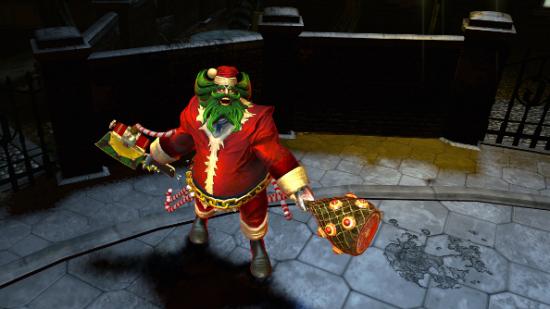Over lunch, Turbine’s Adam Mersky, director of communications, puts it this way, “We have a little experience of going into markets with 800-pound gorillas.”
He’s making the case for why Turbine are ready to to succeed in a MOBA market dominated by Valve’s Dota 2 and Riot’s League of Legends. Turbine have historically been an MMO studio, never the team behind the genre-defining smash hit of the day, but surviving several booms and busts with highly-regarded games that speak to a passionate fan base.
“Everyone called characters in Lord of the Rings Online ‘toons’ [old WoW slang for player-characters] for like, the first eight months. But then once they play, they understand and …start forming their own culture around it. But at this point, you need a point of reference, right?”
Infinite Crisis’ point of reference, for both its potential audience and often for its own developers, is League of Legends. But its guiding inspiration is the the DC Comics universe. It should be a match made in heaven, but first Turbine need to find a way to reconcile their two major influences. Infinite Crisis’ first battle is being waged daily by the development team, as they attempt to define it on its own terms.
The day starts with a battle.
On one side of the large testing room, the five members of the Infinite Crisis Quality team are arrayed at their PCs, ready for a battle. They are led by Infinite Crisis design lead Ryan Bednar.
These are not bug testers like a Quality Assurance team, but more like wine-tasters for the rest of the development team at Turbine. Their job is twofold: to be very, very good at playing Infinite Crisis, and to use their expertise to identify the kind of make-or-break qualitative issues that determine success in the MOBA genre.
Like a fighting a game, a MOBA is all about responsiveness and feedback. Get those things even a little bit wrong, and nobody will stick around to get past them. There are too many other options, and the standards are too high. It’s got to be crisp, fast, and clear at the fundamental level. And then it has to be satisfying for the very best players. All of this — how Infinite Crisis feels, the dynamics of team play at the highest level, the way the layout of the map promotes tactical variety — is down to the Quality team.
But today they’ve got more pressing concerns. Across the room are the five members of compLexity’s League of Legends team, who have been consulting with the Infinite Crisis developers throughout the year. They are doing this in their spare time outside of practicing for the LCS Spring Promotion tournament, where they stand a strong chance of breaking back into the North American LCS division after they lost their slot earlier this year.
In a week or so they will release one of their star players and basically give up on their chances to re-enter LCS, but for now they’re all smiles. Maybe it’s because this is a respite from the “work” of preparing to play professional League. Work that’s increasingly put them at odds with one another.
Their relationship to Infinite Crisis is partially about promotion. They have been playing the game at MLG events and trade shows throughout the year, showcasing it for an audience that is at once curious and skeptical of yet another MOBA, albeit one that boasts the characters from the DC Comics’ “multiverse”.
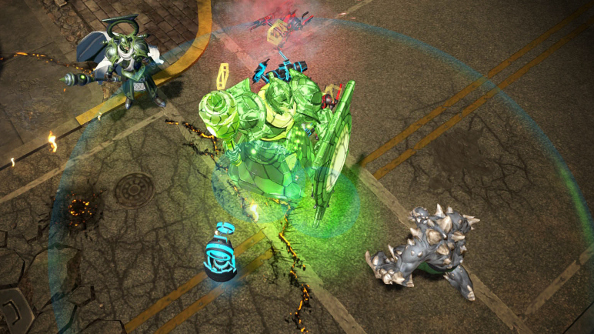
But they are also here to put the game through its paces. As pro-gamers they have reflexes, abilities, and insight that nobody at Turbine can really match. One of the Turbine developers tells me a story about how one of compLexity’s players noticed an issue with the “feel” of one character and commented, offhanded, that one of his powers caused a three or four frame hesitation in the animation. It made the action feel a bit unnatural. It was true, but nobody on the development could see it or define the problem. That’s the kind of precision and insight Turbine want to put to use.
Today, compLexity and the Turbine devs are playing on Gotham Divided, Infinite Crisis’ tri-lane map. It’s the newest addition to the game, and perhaps the most important. The tri-lane map configuration, for better or worse, is the standard for competitive MOBA play. It promotes the classic tactics and class interactions that define the genre.
This is a test run, but there’s also an element of competition to this session. The Quality team feel like they can win this. They play every day, they practice, and they know the map intimately. CompLexity don’t have those advantages, and while they’ll probably be untouchable by day’s end, the Turbine developers feel like they have a decent chance to take the first day of the game.
The teams make their picks. Here compLexity’s inexperience shows as they forego an AD carry — the high-damage DPS class that is crucial for doing sustained damage in team fights and for taking down fortifications. It’s a slip-up that gives the Quality team another advantage. In the meantime, a growing crowd of Infinite Crisis developers filter into the room bearing early-morning coffee and notepads. These kind of high-level play events are a rare event for the team, and they want to soak up as much information as possible. Everything is under a microscope.
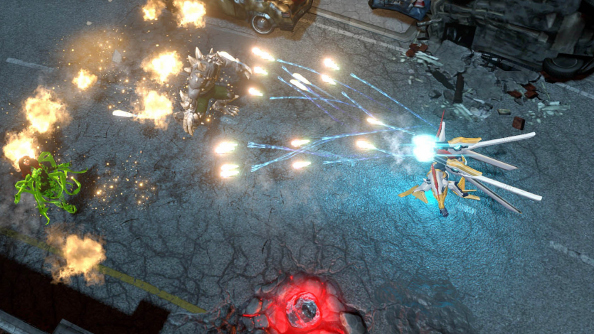
Which makes the Quality team’s embarrassment all that more acute as they start falling behind from the first moments of the match. Even though Infinite Crisis cuts players slack when it comes to last-hitting (getting the final strike on an AI minion whose only purpose is to get killed by heroes) and still awards gold for kills where players don’t get the last hit, compLexity’s efficiency is just leaving the developers in the dust.
The difference is in how the two teams are getting their gold. It hinges on what Turbine call their “kill-collide” model. Skilled players like compLexity get their gold on last-hitting, which splits gold between the teammates but also gives the last-hitter a small personal bonus. Players who miss their last hits, as Quality are doing at level 1, can still run over and pick up coins that fall on the ground. But that wastes a bit of time and movement, so being consistent on last-hits is still a competitive advantage. Between teams of comparable skill, this would give the weaker players a chance to stay in the game even if their “farm” skills are not as good. Against pros, however, the game is starting to snowball.
But even as they do, compLexity’s lack of an AD Carry makes itself felt. They win their fights, but not cleanly, and they can’t make any real progress toward destroying the enemy base. The Turbine team looks like they might be able to crawl their way back into the game. But every time they are starting to make up ground, they get wrecked in another teamfight with compLexity.
The outcome is a foregone conclusion in twenty minutes, but compLexity can’t close the deal. I start to see the spectators’ faces get a bit grimmer and more concerned, and a lot of notebooks are filling with furiously Sharpie’d impressions.
Even compLexity are getting a bit exasperated. After winning another crushing team fight victory and killing four of five Turbine players, they once again can’t bring down the final turret in the crucial mid-lane. “They’re respawning again,” someone calls.
“These timers are way-short,” Patrick “MegaZero” Glinsman complains. At thirty minutes into the match, the entire Turbine team can be resurrected inside of forty seconds. Not enough time for compLexity to put them away, and so the siege resumes. It’s evident that Turbine don’t have a prayer, but compLexity can’t quite bring about the endgame.
Finally, the pros are so powerful that they can just brute-force their way through two consecutive fights, ignoring the respawn timers and bringing down Turbine’s base despite a frantic last-second defense. It was a fifty minute game. About twice as long as it should have been.
After the match, the Turbine develoeprs descend on the progamers or break into conversation circles, going over their notes. Neil “PR0LLY” Hammad is surrounded by three or four developers as he explains why he thought the towers themselves weren’t doing enough damage to players. “But I absolutely fell in love with my guy’s passive,” he says. “Like, I want to bring Mecha-Wonder Woman over to LoL.”
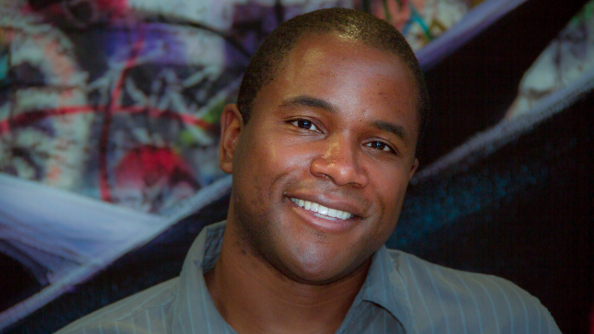
Assessment
Cardell Kerr is the creative director of Infinite Crisis. Right now, his game’s chief crisis is one of identity.
“What is the thing that makes Infinite Crisis Infinite Crisis?,” he asks. “At first there was a lot of feedback in terms of our initial attempts at Gotham Divided that didn’t feel like our game. We were looking at the Coast City map, trying to figure out why Coast City felt like our game, but Gotham Divided doesn’t feel like our game. It came back around to the unrelenting action that is what is the core of what Coast City is.”
Coast City is the smaller, faster map for Infinite Crisis. Where Gotham Heights is just a general melee over control points, Coast City is more objective based, yet confined enough to keep forcing teams into major engagements. And that’s the point: “Unrelenting action” is a design pillar, a guiding principle that should get all the all the elements of this complicated game pulling in the same direction.
“Coast City is just constant struggle on both sides – there’s always stuff going on, it’s actually one of the most difficult things in the world to try and cast over, because you’re always missing something. Other games are just not like that. League’s not like that, Dota isn’t like that. They’re generally slower, they’re more deliberate. There’s a point where there’s just a long period of time to lose in some cases. And that is not what the heart of our product is.”
Bednar jumps in: “We had a play-day yesterday, in which – this is ridiculous – we had a one-on-one team fight that went on for three minutes. People were respawning and then coming back into the jungle like, just completely ignoring other objectives! And I feel like that is the opportunity for us – to make sure that that level of aggression is present in this game as much as possible.”
Kerr wants to get rid of any obstacles to that.
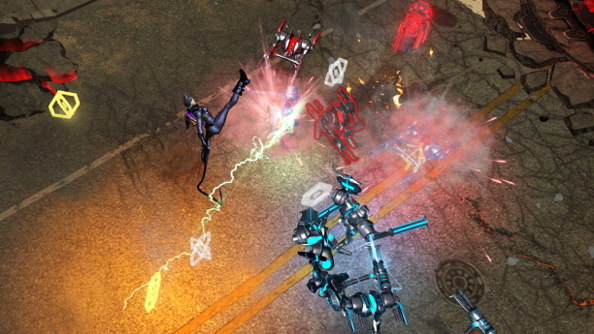
“What I really want in our game at this point of time is just really… aggression. I want it to be a true, full-bore superhero brawl. …This is why drones don’t aggro you if you’re fighting another person, as long as there’s another target. So your drones will be fighting, and that’s fine, but if Superman at that point in time wants to fight with Joker then that’s what’s going to happen,” he says.
Bednar thinks the hybrid hit farming system has helped with that. Players make aggressive moves between the two drone lines to pick up loose gold, and that adds volatility.
“It’s forcing you forward; it’s forcing more gank opportunities for the other team, and also some more harassment from the enemy player, and so there’s even more tension in our laning phase than you’ll see in most other MOBAs, I think.”
The kill-collide model of farm will likely be a controversial one for MOBA fans. It somewhat mitigates the effect of poor skill. It’s also not entirely balanced yet, with solo-laners easily leading their teams in gold by a wide margin. While Kerr doesn’t want weaker players to feel like they’re being punished, he does want better ones to be empowered. A great player or two can and should be able to carry their team to victory. It’s fundamental to Infinite Crisis.
“If you can’t recognise individual player skill, I don’t feel it’s a sport anymore. I keep going back to basketball as an example. You can look at any great champions of the series and be like ‘Kobe carried the Lakers in this time.’ You need that, and that is important even if your entire team wins. If you share too much, you’ll end up with some significant problems. And also it tends to dilute team makeup and make everything about team composition, which I’m also not a fan of – I don’t want to force a meta on how people play.” He pauses, then smiles, “And to a certain extent you saw that today.”
But is it DC?
Yet there remains that problem that Kerr is working on. Why does Coast City feel different, like it’s unique to Infinite Crisis, and Gotham Divided does not? Part of it is the tri-lane structure itself. It is the standard for the MOBA genre, but it also tends to enforce norms that Turbine are trying to change or escape. Towers put brakes on the action and necessitate a focus on farming, which inhibits direct conflict. It may be a more tactical and deliberate game, but it’s not the super-hero brawl that Cardell and Bednar see in their minds’ eye. It’s telling that Gotham Divided’s best moments come after the outer towers come down, and the sprawling, intricate “jungle” of alleys and side-streets become home for a game of cat-and-mouse between gangs of superheroes.
There’s something else, though. Gotham Divided relies more heavily than any other map on standard MOBA mechanics And those are hard to square with the DC universes and characters. For instance, units hide in hologram-like stealth fields. Instead of regular creeps, the heroes and villains of Infinite Crisis bash on little robots with riot gear.
While it’s visually consistent across a variety of maps, the drones never quite look like they belong there with Superman, Batman, and their cross-dimensional counterparts. They are there, really, just because MOBA champions need creeps to farm, and because little robots are inoffensive enough for various DC heroes to slaughter without compunction.
“They’ve got to be fine for Superman to kill over and over again — if it’s people then it gets a little weird,” Bednar says with a laugh.
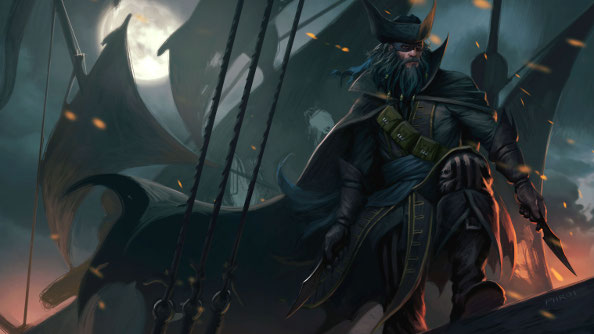
But this is the difficulty: comics and comic book heroes are all about specificity. Batman and Gotham City inform one another: they gothic, brooding, over the top. Superman and Metropolis are blandly attractive, unthreatening, optimistic. Infinite Crisis is trying not just to make all these characters go together (not easy when Harley Quinn, Mecha Wonder Woman, and Superman are all on a team) but then create a visual language that will work across every environment and every cast of characters.
Gotham Divided is built around things like towers, drones, and team objectives and so it call attention to the strangeness of Infinite Crisis, and the fact that these heroes and villains with household names are busily smashing robots to no clear purpose. What does a world where three different versions of Batman, a Gaslight Joker straight out of Sweeney Todd, and Mecha-Wonder Woman can all do battle actually look like? How do they go together, and why do they even care about drones? Why do two giant robots, the Raider and Leviathan, give special bonuses to either team?
These features stand out more because there is so much potential for weirdness in Infinite Crisis. Right now Infinite Crisis is battling the “jumpsuit problem”: most every character has a similar humanoid build and similar clothing. The characters from outside the main universe, like the fat Gaslight Joker carrying a cartoonishly large roast or the Nightmare Batman who appears to be an actual bat, tend to be a little more distinctive.
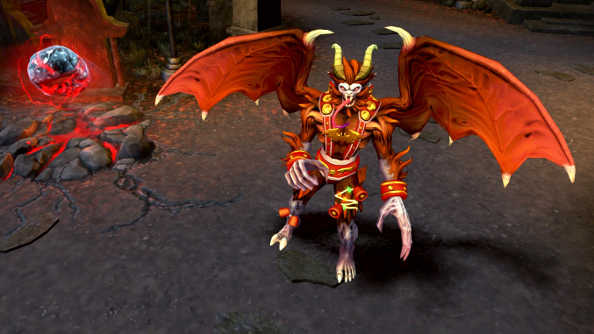
But if the art and lore teams get their way, they’ll be positively tame compared to some of the Silver Age absurdities people are lobbying for. Apparently there’s a number of artists who hell-bent on finding a way to get a giant, evil starfish into Infinite Crisis based on the strength of a single old Justice League cover.
Gotham Divided points back to Infinite Crisis’ influences and future rivals, and the genre conventions they’ve established. But it’s probably not going to win a following based on how well it adapts those conventions to its own comic book universe mashup. What’s going to get people’s attention is the superhero action and videogame absurdity that Infinite Crisis sometimes has, like when Superman grabs a giant moulded hard-shell taco from off a Coast City Mexican food stand and sends it flying at an enemy, or when Harley Quinn uses a giant mallet to knock Green Arrow into the midst of her team to help them win an easy kill.
Toward the end of the day, I talk to Patrick “MegaZero” Glinsman about whether he’d actually consider leaving League of Legends for Infinite Crisis, or if there are particular things he liked or disliked about it compared to other MOBAs. He talks about the pluses and minuses of their experience model and their jungle layout, but then admits the game itself almost doesn’t matter.
“To me, I guess that’s a hard question. I would just play whatever my friends are playing,” he says. “The MOBA itself doesn’t matter too much to me. What’s a game I can group up and play with my friends. If my friends all like superheroes, I guess I’ll go play that.”
People will show up for the superheroes. They’ll stay for the socializing and team play. And out of that, Turbine hope, a new competitive MOBA will arise. But first things first: they’ve got to build a game worthy of DC’s cast of superhumans. Bit by bit, they’re getting there.
